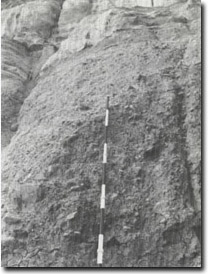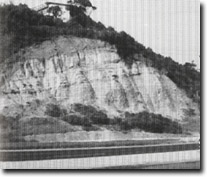PP63. Olivers Hill - Tertiary Sections
|
This information has been developed from one or more of these publications:
|
| Location: | 344653. Base of Olivers Hill on the eastern side of the Nepean Highway between Somme Ave and Warringa Road, Frankston. |  Site 63. Conglomerate bed at Olivers Hill |
Access: | Nepean Highway. | |
Ownership/Managing Authority: | Crown land (Road Construction Authority) and private land. | |
Site Description: | A cliff slope developed by an old landslip at the base of Olivers Hill exposes a Tertiary sediment sequence underlying weathered Older Volcanics basalt. The most distinctive bed, at the base of the section, is a weathered conglomerate with cobbles and boulders of Palaeozoic sandstone, shale, quartzite and slate set in a sandy clay matrix. The conglomerate rests on weathered granite but the contact is obscured by slope wash debris. The sediments dip northward at an angle of about 15 degrees. | |
Significance: | Regional. This is the best exposure of sub-basaltic sediments on the eastern coast of Port Phillip Bay. This is an excellent site to determine the environment of deposition of this material and makes a natural starting point for geological excursions examining the Tertiary geology of the Mornington Peninsula. It has been exposed for at least 90 years and is a stable and accessible site for senior geology students. | |
Management Considerations: | Class 1. The exposure is relatively stable despite the numerous small rills. It should be retained as a geological exposure and not regraded or artificially covered. If highway safety (from slipping or falling material) is perceived as an issue, investigation should be made to providing a protective fence or barrier rather than covering the slope. An elevated, rather than an excavated footpath, would ensure safe access to the lower part of the exposure. | |
References: | Kitson, A.E. (1900). Report on the coastline and adjacent country between Frankston, Mornington and Dromana. Geol. Surv. Vict. Prog. Rep. 12, 1-13. Gostin, V.A. (1966). Tertiary stratigraphy of the Mornington district, Victoria. Proc. R. Soc. Vict., 79, 459-512. | |
 Site 63. Northward dipping Tertiary sediments, Olivers Hill, Frankston |



